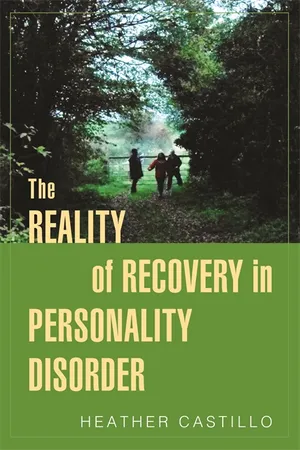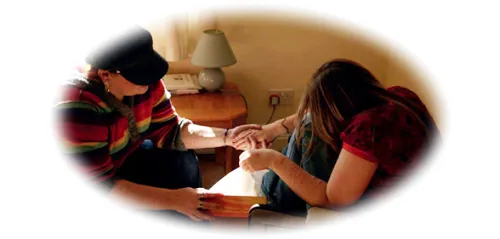![]()
CHAPTER 1
The Journey Begins
Nearly every other day I was tying things around my neck, overdosing, cutting myself, starving myself … I used to wake up every day, wanting to die, finding a way, thinking of a way that I could harm myself when I was in hospital, trying to trick people into like thinking I was okay, trying to sneak things in, but looking around constantly for something I could do, and that was my life, trying to find a way to actually harm myself. I didn’t want to live. I didn’t have any hopes or dreams. I just thought my life was going to be in hospital.
Service User Quotation
This book tells of a journey taken by a group of service users who had attracted a diagnosis of personality disorder, a journey that spans 20 years. It is an account that aspires to show the inner world of personality disorder from the perspective of service users. It aims to examine the process of recovery for those with this diagnosis and it suggests evidence-based ways forward for support and treatment. It is both a cautionary tale and a story of hope.
Some lives appear to have fault lines running through them, fatal flaws. It was in the early 1990s, in North East Essex in England that I first stepped into a psychiatric ward. I saw a young woman with cuts covering her arms. I wondered who could have done such a thing to her, not realizing that they were self-inflicted. I did not know how or why such acts should come to be. I did not understand why human beings, who held a life in common with me, should be driven to such acts. Here was the beginning of my particular part of this journey.
At that time, as a mental health advocate working for Mind organizations in North East Essex, and based at the local psychiatric acute inpatient hospital, the advocacy office was a frequent port of call for service users with a diagnosis of personality disorder. The themes they brought were consistent: discharge from hospital immanent even though still suicidal; being sectioned into hospital under the Mental Health Act and subject to close observation; being transferred to a secure hospital; at risk of losing children via child protection procedures; ending in prison; and a whole gamut of desperate outcomes, all contributing to a compounding of symptoms and feelings of being fundamentally and irrevocably misunderstood.
One man wandered aimlessly into the Mind office saying that the psychiatrist had told him there was nothing that could be done for him because he had personality disorder. Later that year he was dead. A woman in the local psychiatric hospital ward, who was self-starving to a dangerous degree, was told in exasperated terms that she simply needed to start eating. These were not isolated examples and I became consumed with questions about this diagnosis. As an advocate I became the listener…to stories about lives where there seemed no mercy, where the world appeared treacherous and full of chaos and without reason and where the effects of time, visible and invisible, had dissolved hope. At that time I was involved in a kind of mental health advocacy that I believe has gone out of fashion. This was advocacy used to articulate the views of people generally not heard. It was advocacy inspired by such activists as Larry Gostin, the American lawyer who was the first legal director of National Mind, and whose book A Human Condition (1975) was largely responsible for reforms embraced in the UK 1983 Mental Health Act. I questioned whether, as an advocate, I could be the purveyor of stories of suffering and injustice that might lead to understanding and change.
Consequently, by 1998, I had embarked on what was to be the first of two research studies about personality disorder diagnosis. Together with local service users, I formed a research group comprised of people who had attracted the diagnosis with the aim of carrying out research about personality disorder from the service users’ perspective. The group met monthly throughout 1999. Attendees were not survivors engaged in a retrospective study, but were service users in the midst of their difficulties, struggling for emotional equilibrium while engaged in the research endeavour. Some were inpatients and came to the group meetings from hospital wards each month, some came even though sectioned under the Mental Health Act. In a client group considered inconsistent, undependable and untreatable, the dedicated commitment from participants provided a contradictory picture; it was breath-taking.
Our research approach was emancipatory. Described by Freire (1970) as a method which challenges the validity of the privileged effectively analyzing the underprivileged, here the research tools would be given to the people (Ramon, Castillo and Morant 2001). By December 1999 the final interview was completed and, capturing the voice of the sample, the data collected from the group and the questionnaires yielded a vast quantity of perspectives including 15,000 service user words. In a climate that emphasized issues of risk and danger, and where personality disorder was considered untreatable in many quarters, part of the purpose in carrying out the first study was to engender some kind of compassion and understanding in relation to this diagnosis.
The study consisted of 50 participants, 20 men and 30 women, aged between 18 and 74 years. At a time when early abusive experiences were not so readily linked to present condition, the findings revealed that 88 per cent of the sample had experienced abuse. For 80 per cent this was childhood abuse, sexual, emotional, violent, and sometimes combinations of all three, constituting brutal life experiences. Twenty per cent made the discovery that they had the diagnosis indirectly, from records, reports or at social services meetings. Others appear to have been told about the diagnosis after many years; some were told by professionals only after they had asked. Seventy-two per cent of respondents considered they had received bad treatment because of the label. Confirming that the diagnosis is stigmatizing, they described their experiences of being treated as a ‘service leper’, ‘let’s give her a wide berth’, ‘you’re ignored’, ‘hostility’, ‘not mental illness’, ‘brought on oneself’, ‘people seem to be scared of the diagnosis’, ‘it’s saying troublemaker’. What service users said during the interviews highlighted the sense of exclusion and hopelessness connected to finding out they had been given this diagnosis, and gave some sense of the impact this information might have on an individual labouring with the desperately hard task of living with the truth of an early abusive history.
Data analysis questioned the validity of the classification of personality disorder and the sub-categories within it. For those involved in our study, unresolved trauma had resulted in suicide attempts of such lethality that survival seemed miraculous. Anger and hatred had become dammed up behind a narrow response function. Where early life had been sexually or violently abusive, or simply consisted of an unloving and devastating non-response from care-givers, the blunt limitations of their experience had left some stripped of control and disempowered beyond comprehension.
From the year 2000 we began to present our findings at national conferences and we published a number of journal articles. Interest in our endeavour was heartening and liberating for the service users involved in the study and it was eventually published as a book, Personality Disorder: Temperament or Trauma? (Castillo 2003). At this time we did not know that our journey was simply beginning and that there was still so far to travel.
![]()
CHAPTER 2
Prevailing Knowledge Relevant to the Journey
It is no wonder that those of us with a personality disorder diagnosis feel like second, or more like third class citizens (life’s rejects). You only have to look at the definitions given in ICD 10 and DSM IV (the psychiatric diagnostic manuals) and read comments such as ‘limited capacity to express feelings; disregard for social obligations; callous unconcern for others; deviant social behaviour; inconsiderate of others; incompetence; threatening or untrustworthy’. The list is endless, but one thing that these comments have in common is that they are not helpful in any way.
Service User Quotation
Before recounting the details of the next stage of our story, it is important to examine existing knowledge relevant to this journey. How does the law relate to personality disorder? What is personality disorder and what is its prevalence? What treatments have been developed and what is meant by recovery?
Mental health law
The Mental Health Act in the UK, relevant to England and Wales, covers the reception, care and treatment of mentally disordered people, the management of their property and other related matters. Centrally, it provides the legislation by which people diagnosed with a mental disorder can be detained in hospital or police custody, under a section of the Act, and can have their disorder assessed or treated against their wishes, colloquially known as ‘sectioning’.
The term psychopathic disorder, used synonymously with personality disorder, became included in legislation in the 1959 Mental Health Act, with a clause in the 1983 Act requiring that those detained must be amenable to treatment to justify detention. Problems arose regarding the question of treatability and this remained a major consideration in proposed revisions of the 1983 Mental Health Act. Perhaps the most high profile event in relation to these concerns was the Russell murders (Edwards 2012). Michael Stone, a man diagnosed with personality disorder, had been discharged from psychiatric hospital as he was considered to be untreatable. In 1996, he went on to murder Dr Megan Russell and her six-year-old daughter while they were out walking their dog in a country meadow. Josie, the nine-year-old daughter who accompanied them, was attacked but survived. She was mute for some months and her appearance with her father on national television touched the nation’s hearts. Brutal murder and personality disorder began to feature synonymously in the press. In July 1999, the Home Office issued policy proposals for managing dangerous people with severe personality disorder suggesting removal to special units, without deterioration in clinical state, if deemed potentially dangerous to the public (Department of Health 1999). This caused fairly widespread fear amongst those with the diagnosis, the vast majority of whom had harmed only themselves and not others. The advocacy service began to hear from anxious service users who had at some time received the diagnosis or who had at one time assaulted another, no matter how minor the offence. Notwithstanding assurances regarding the small number proposed for indeterminate detention, and their historical dangerousness, many were not calmed. Soon after, I heard a social worker speaking at a conference and likening the new proposals for preventative detention to the Tom Cruise film, Minority Report. Here a futuristic task force operates clairvoyant electronic equipment to predict the next time and place a crime will be committed and then identifies the culprit needing to be apprehended before they have actually perpetrated the crime. Many of us in the audience believed that this social worker who compared new Mental Health Act proposals to Minority Report had a point.
In December 1999, a unique coalition of 26 health organizations, disability, legal, civil rights and religious organizations published a joint statement expressing common concerns over government proposals for people diagnosed with severe personality disorder. Members of this coalition included The Church of England, The Community Psychiatric Nurses Association, The Law Society, The Mental Health Foundation, The Royal College of Psychiatrists, Community Health Councils, WISH (Women in Secure Hospitals), The United Kingdom Advocacy Network, National Mind and others. Issues highlighted included the exclusion from services of people with personality disorder; that there was no clear consensus regarding diagnosis; the difficulties inherent in risk assessment; the possibility of non-offenders (those who had not committed a criminal act) being detained against their will regardless of whether it was considered that they could be treated or not; the call for more research into what could best provide treatment and care for people with personality disorder, both those in the community and those detained in penal, restrictive establishments. This coalition became the Mental Health Alliance, a coalition of 75 organizations working together to secure better mental health legislation.
As illustrated above, the treatabil...


